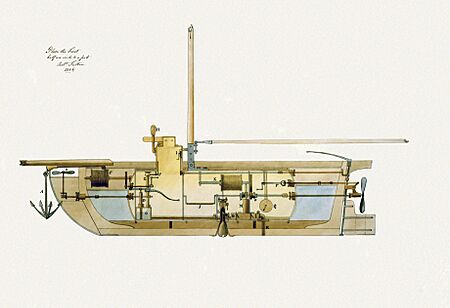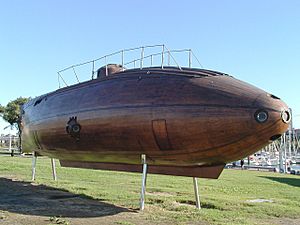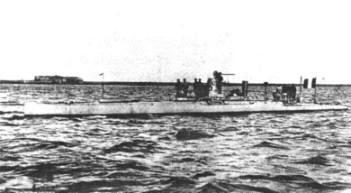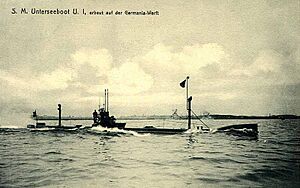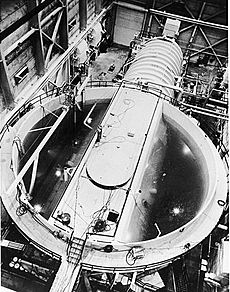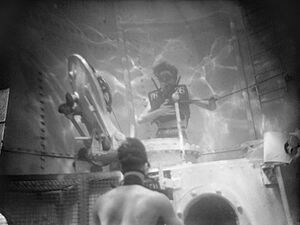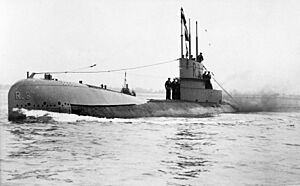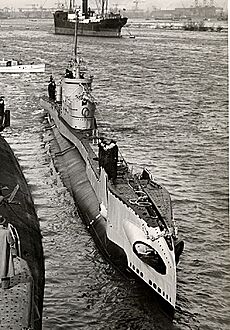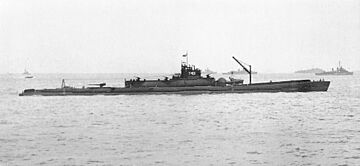History of submarines facts for kids
The history of the submarine is a super interesting journey that goes all the way back to ancient times! People have always been curious about traveling underwater. They've used submarines for exploring the ocean, having fun, doing scientific research, and especially for fighting in wars.
Early attempts at underwater travel, like those imagined for Alexander the Great, were very basic. But then, new ways to power submarines, different fuels, and cool inventions like sonar really made submarine technology zoom forward! When the diesel engine came along, and later the nuclear submarine, submarines became much more common, especially for military use during World War I, World War II, and the Cold War.
During World War II, German U-Boats were famous for battling the British Royal Navy and sinking merchant ships. In the Cold War, the United States and Russia used submarines a lot, which made them a big part of popular culture. These conflicts also showed how important military submarines were for secret missions, hidden warfare, and as a way to prevent nuclear attacks. Today, countries like North Korea, China, the United States, and Russia still use military submarines.
But submarines aren't just for war! They're also used for fun and science. They help us explore the deep sea floor and the very deepest parts of the ocean. Submarines are also super important for search and rescue missions, helping other submarines, surface ships, and even aircraft. They can go much deeper than scuba diving allows, making them perfect for both exploration and recreation. Submarines continue to be a popular topic in books and movies too!
Contents
- Early Underwater Explorers
- Early Modern Submarines
- Mechanical Power for Submarines
- Electric Power and Modern Designs
- Modern Submarines Emerge
- Submarines Between the World Wars
- Nuclear Power and Missile Submarines
- Recent Submarine Innovations
- Submarine Technology
- Submarines in Warfare
- Major Submarine Incidents
- Images for kids
- See Also
Early Underwater Explorers

The idea of fighting underwater is very old. Ancient drawings show people using hollow sticks to breathe underwater for hunting. The first time divers were used in war was during the siege of Syracuse (415–413 BC), where they cleared underwater obstacles. Later, legends even said Alexander the Great went underwater in a simple diving bell, as seen in a 16th-century painting.
In 1562, a report said that two Greeks went underwater in the Tagus river in Toledo. They stayed dry and even kept a flame burning!
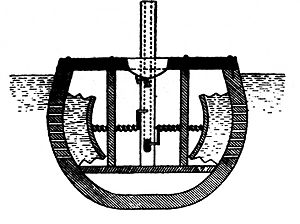
Many plans for submarines appeared during the Middle Ages. In 1578, an Englishman named William Bourne designed a submarine. It was meant to be a fully closed boat that could be rowed underwater. His design was a wooden boat covered in waterproof leather. To dive, hand-operated plungers would push against flexible leather bags, letting water in or out to change the boat's buoyancy. His drawing shows a crank to adjust depth, but it's not clear how the crew would fit inside.
In 1596, the Scottish mathematician John Napier wrote about "sayling under water." It's not known if he ever built anything. However, his friend Henry Briggs knew Cornelius Van Drebbel, a Dutchman who worked for James I of England. Drebbel built the first successful submarine in 1620.

Drebbel's submarine was powered by oars. We don't know exactly what it looked like; it might have been a bell pulled by another boat. He tested two improved versions in the River Thames between 1620 and 1624. One report from 1651 said that Drebbel calmly dived underwater, keeping the king and thousands of Londoners in suspense. People thought he was lost, but he suddenly surfaced far away, showing that he and his companions had been comfortable underwater. They could sit on the bottom or rise to the surface, and even move around without losing light. This made people think about how useful this invention could be in war, for secretly attacking enemy ships.
In 1690, Drebbel's son mentioned that his father used a quicksilver barometer to measure how deep the boat had gone. To solve the problem of running out of oxygen, Drebbel found a way to create oxygen from saltpetre. He wrote about how saltpetre could be broken down by fire to create air, similar to how water on a hot iron makes a loud noise as it expands.
People at the time found Drebbel's ideas amazing. The famous astronomer Johannes Kepler even said in 1607 that if Drebbel could create a new "spirit" to move his invention without weights, he would be like a god!
Even though early submarines were for exploring, inventors quickly saw their military potential. In 1648, Bishop John Wilkins wrote about the strategic benefits of submarines in his book Mathematical Magick.
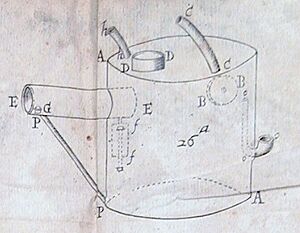
Between 1690 and 1692, the French physicist Denis Papin designed and built two submarines. His first design was a strong, heavy metal box with a pump to push air into the hull and increase pressure. When the pressure was right, holes would open to let water in for diving. This first machine was accidentally destroyed. His second design (1692) was oval-shaped and worked similarly, using a water pump to control buoyancy. Some reports say Papin had some success with his second design on the River Lahn.
By the mid-1700s, England had granted over a dozen patents for submarines. In 1747, Nathaniel Symons patented and built the first known working example of a ballast tank system. His design used leather bags that filled with water to submerge the craft. A mechanism twisted the water out to make the boat resurface. After this, submarine design didn't change much for over a century, waiting for new industrial technologies to help with propulsion and stability.
Early Modern Submarines
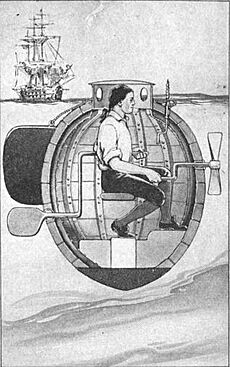
The first American military submarine was the Turtle in 1776. It was a hand-powered, egg-shaped device designed by David Bushnell for one person. It was the first submarine that could move and operate independently underwater, and the first to use screws for propulsion. However, some historians believe the Turtle might have been a propaganda story. There are no British records of a submarine attack during the war. Replicas of the Turtle have been built to test its design. One replica even got close to the RMS Queen Mary 2 in New York City before being stopped by police!
You can see replicas of the Turtle in museums like the Connecticut River Museum, the U.S. Navy's Submarine Force Library and Museum, Britain's Royal Navy Submarine Museum, and Monaco's Oceanographic Museum.
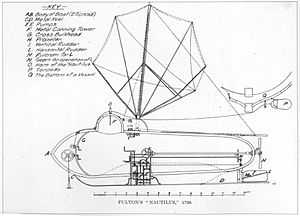
In 1800, the French Navy built a human-powered submarine called the Nautilus, designed by Robert Fulton. It was the first submarine to use two types of power: a sail for the surface and human power underwater. It even showed it could use mines to destroy two warships! Both the French and British navies eventually decided not to use Fulton's design.
In 1834, Russian General Karl Andreevich Shilder showed Emperor Nicholas I the first submarine equipped with rockets.
The Submarino Hipopótamo, the first submarine built in South America, was tested in Ecuador in 1837. Its designer, Jose Rodriguez Lavandera, successfully crossed the Guayas River. The Hipopotamo crossed the river two more times but was abandoned due to lack of money.
In 1851, a Bavarian corporal named Wilhelm Bauer took his submarine, the Brandtaucher (fire-diver), to sea in Kiel Harbour. It sank, but the three crew members escaped.
During the American Civil War, both sides used submarines. The Union had the Alligator, and the Confederacy had the Hunley. The Hunley was the first submarine to successfully attack and sink an enemy warship.
In 1863, the Sub Marine Explorer was built by Julius H. Kroehl. It had a special pressurized room that allowed the crew to leave and enter the submarine underwater. This was a very early version of modern diving chambers, though people didn't fully understand decompression sickness (the bends) back then. After its first public dive in 1866, the Sub Marine Explorer was used for pearl diving off Panama. It could dive deeper than 31 meters (100 feet), which was deeper than any submarine before it.
In 1865, the Chilean government ordered the Flach during the Chincha Islands War. Built by Karl Flach, it sank during tests in Valparaiso Bay in 1866, with all eleven crew members lost.
During the War of the Pacific in 1879, Peru built the Toro Submarino, designed by Federico Blume. It's considered the first working submarine in Latin America. It was 48 feet long, manually operated by 11 people, and could dive to 12 feet with a ventilation system. It had a speed of 3 knots and could dive a maximum of 72 feet. It was fully ready to attack with naval mines during the Blockade of Callao but was sunk by its own crew in 1881 to prevent it from being captured by Chilean troops.
Mechanical Power for Submarines
The first submarine that didn't rely on human power was the French Navy's Plongeur, launched in 1863. It used a special engine powered by compressed air from 23 tanks. However, it was very hard to control underwater and had poor speed.
The Ictineo II, designed by Spanish engineer Narcís Monturiol, was the first submarine that didn't need outside air and used a combustion engine. It was first launched in 1864, powered by 16 men. In 1867, it was changed to use peroxide and steam for power. This 14-meter (46-foot) craft had a crew of two, could dive to 30 meters (98 feet), and stayed underwater for two hours. On the surface, it used a steam engine. But underwater, a steam engine would quickly use up the submarine's oxygen. To fix this, Monturiol invented an air-independent propulsion system. This system not only powered the submarine but also released oxygen into the hull for the crew. Monturiol's double-hulled submarines also solved problems with pressure, buoyancy, stability, and diving that earlier designs faced.
Submarines became a real weapon when the first practical self-propelled torpedoes were invented. The Whitehead torpedo, designed in 1866 by British engineer Robert Whitehead, was the first. This "mine ship" was 11 feet long, 14 inches in diameter, powered by compressed air, and carried an explosive warhead. It could go 7 knots and hit a target 700 yards away. Many navies bought Whitehead torpedoes in the 1870s. It was first used in battle in 1878 during the Russo-Turkish War, when Russian torpedo boats sank the Turkish ship Intibah.
In the 1870s and 1880s, the basic shape of modern submarines began to appear, thanks to inventors like Englishman George Garrett and his backer Thorsten Nordenfelt, and Irish inventor John Philip Holland.

In 1878, Garrett built a 14-foot (4.3-meter) hand-cranked submarine called the Resurgam. Then came the more famous Resurgam of 1879, built in England. It was made of iron plates and wood, 45 feet (14 meters) long, weighed 30 tons, and had a crew of 3. The Resurgam was powered by a special steam engine that could run for up to 4 hours underwater. It was designed to float naturally, and diving was controlled by hydroplanes in the middle. It cost £1,538.
Garrett's design had problems, like intense heat from the steam boiler and stability issues. But it caught the eye of Swedish industrialist Thorsten Nordenfelt. Together, they created the first practical steam-powered submarines armed with torpedoes for military use.

The first of these was the Nordenfelt I in 1885, a 56-ton, 19.5-meter (64-foot) vessel similar to Garrett's Resurgam. It had a range of 240 kilometers (150 miles) and one torpedo. Like Resurgam, Nordenfelt I used steam on the surface and then shut down its engine to dive. While submerged, it used stored pressure for propulsion. Greece bought it because they feared the Ottomans. Nordenfelt then had Nordenfelt II (Abdül Hamid) and Nordenfelt III (Abdül Mecid) built in England in 1886 and 1887. These were powered by a coal-fired steam engine, carried two torpedo tubes and two machine guns. They could dive to 160 feet (49 meters). The Abdülhamid became the first submarine in history to fire a torpedo while submerged!
Nordenfelt's work ended in 1887 with Nordenfelt IV, which had two motors and two torpedoes. It was sold to Russia but soon got stuck and was scrapped. Garrett and Nordenfelt made big steps in building the first modern, military-ready submarines, sparking interest around the world. However, basic problems like propulsion, quick diving, and staying balanced underwater were still unsolved. These would be fixed in the 1890s.
Electric Power and Modern Designs
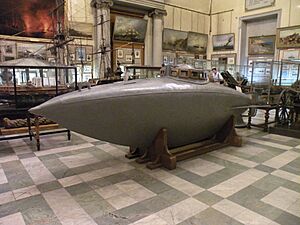
A reliable way to power submerged submarines became possible in the 1880s with the invention of electric batteries. The first electrically powered submarines were built by Polish engineer Stefan Drzewiecki in Russia in 1881. Other engineers later used his ideas.
In 1884, Drzewiecki changed two mechanical submarines, adding a 1-horsepower engine with new batteries. In tests, these submarines traveled underwater against the Neva River's current at 4 knots. They were the world's first electric-powered submarines.
In England, the Nautilus was built in 1886. It was 60 feet long with a 13-horsepower engine powered by 52 batteries. It was advanced but got stuck in mud during trials. Waddington's Porpoise showed more promise. It was similar in size to the Resurgam and used 45 large batteries to power a propeller, giving it a speed of 8 mph for at least 8 hours. It carried two external torpedoes and a mine torpedo. Even though it performed well, Waddington couldn't get more contracts and went bankrupt.
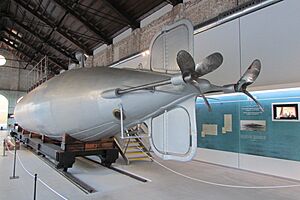
In France, early electric submarines like Goubet I and Goubet II were not very successful. But they inspired naval architect Henri Dupuy de Lôme to design his own advanced electric submarine, almost 20 meters (66 feet) long. He died before it was finished, but Gustave Zédé completed it in 1888 and named it the Gymnote. It was one of the first truly successful electric submarines, with an early periscope and an electric gyrocompass for navigation. It made over 2,000 successful dives using a 204-cell battery. Even though the Gymnote had limited range, its side hydroplanes became standard for future submarine designs.
The Peral Submarine, built by Isaac Peral, was launched by the Spanish Navy in 1888. It had three torpedoes and one torpedo tube in the front, new air systems, a modern hull shape, propeller, and external controls that looked like much later designs. The Peral was an all-electric submarine with an underwater speed of 3 knots. After two years of tests, the project was stopped by naval officials, partly because of concerns about the battery's range.
Many more submarine designs were built during this time, but navies didn't widely use them until the early 1900s.
Modern Submarines Emerge

The early 1900s were a key time for submarines. Many important technologies appeared, and several countries started using submarines widely. Diesel electric power became the main way to run submarines, and tools like the periscope became standard. Batteries were used for underwater travel, and gasoline or diesel engines were used on the surface and to recharge the batteries. Early boats used gasoline, but quickly switched to kerosene and then diesel because they were less likely to catch fire. Submarines and their weapons improved in the early 1900s, and they would have a huge impact on 20th-century warfare.
The Irish inventor John Philip Holland built a model submarine in 1876 and a full-size one in 1878, followed by others that weren't as successful. In 1896, he designed the Holland Type VI submarine. This vessel used an internal combustion engine on the surface and electric battery power for underwater operations. It was launched in 1897 and bought by the United States Navy in 1900, becoming the first commissioned U.S. Navy submarine, renamed USS Holland.
A prototype of the A-class submarine, called Fulton, was developed in 1900. The Fulton was never commissioned by the U.S. Navy and was sold to Russia in 1905. In 1902, Holland received a U.S. patent for his work on the modern submarine. Many countries were interested and bought the rights to build his designs.
The British Royal Navy ordered the Holland-class submarine from Vickers, under license from Holland's company, between 1901 and 1903. The first one was ready for a diving trial in 1902. Even though the design was bought from the U.S., the British used an improved version with a new 180-horsepower petrol engine.
Meanwhile, the French steam and electric Narval was commissioned in 1900. It introduced the classic double-hull design, with a strong inner hull inside an outer shell. These 200-ton ships could travel over 100 miles underwater. The French submarine Aigrette in 1904 improved this by using a diesel engine instead of gasoline for surface power. Many of these submarines were built, with 76 completed before 1914.
By 1914, all the major world powers had submarine fleets, though they were still figuring out how to use them in war.
At the start of World War I, the British Royal Navy had the largest submarine fleet, with 74 boats. Fifteen of these could travel across oceans, and the rest were for coastal patrols. The D-class submarines, built from 1907–1910, used diesel engines on the surface to avoid problems with petrol engines. These boats were designed for long trips, with a range of 2,500 nautical miles at 10 knots on the surface, and much better living conditions for the crew. They had two propellers for better steering and innovative saddle tanks. They were also the first submarines with deck guns in front of the conning tower. They also had three torpedo tubes. D-class submarines were the first to have standard wireless radios. Their enlarged bridge made them look like modern submarines. The prototype D1 was built in secret because it was so innovative.
The British also tried other power sources. Oil-fired steam turbines powered the British "K" class submarines built during and after World War I, but these weren't very successful. The goal was to make them fast enough to keep up with the British battle fleet.
The Germans were slower to see how important submarines would be. Their first U-boat, U-1, was commissioned in 1906. It had a double hull, used a Körting kerosene engine, and had one torpedo tube. A diesel engine wasn't installed in a German navy boat until the U-19 class in 1912–13. At the start of World War I, Germany had 20 submarines in service.
Submarines Between the World Wars
Diesel submarines needed air for their engines, so they carried very large batteries for traveling underwater. These batteries limited how fast and how far submarines could go when submerged.
An early submarine snorkel was designed in 1916 by James Richardson in Scotland. The snorkel allowed the submarine to stay hidden for long periods by traveling underwater using its diesel engines, which also charged the batteries. The British Navy didn't use this design at the time.
The first German U-boat to get a snorkel was U-58, which tested it in 1943. This technology came from Dutch experiments in 1938 with a device called a snuiver (sniffer). This simple pipe system allowed submarines like HNLMS O 19 and O 20 to travel at periscope depth using their diesels, giving them almost unlimited underwater range while charging their batteries. German U-boats started using snorkels in early 1944. By June 1944, about half of the U-boats in French bases had snorkels.
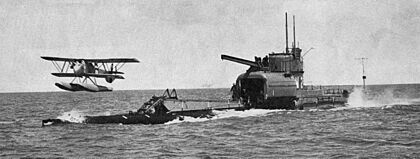
Many new submarine designs appeared between the wars. One notable type was the submarine aircraft carrier. These submarines had a waterproof hangar and a steam catapult to launch and recover small seaplanes. The submarine and its plane could act as a scouting unit for the fleet, which was very important before radar was available. The British HMS M2 was an early example, followed by the French Surcouf, and many aircraft-carrying submarines in the Imperial Japanese Navy.
Early submarine designs put the diesel engine and the electric motor on the same shaft, which also turned the propeller. Clutches allowed the engine to drive the electric motor as a generator to recharge batteries and also propel the submarine. When the boat dived, the clutch would disconnect the engine, and the motor would turn the propeller.
In the 1930s, this system was changed for some submarines, especially those of the U.S. Navy and the British U class. The engine was no longer directly connected to the motor/propeller shaft. Instead, it drove a separate generator, which powered the motors on the surface and/or recharged the batteries. This diesel-electric system offered much more flexibility. For example, the submarine could travel slowly while the engines ran at full power to recharge batteries quickly, reducing time on the surface or using its snorkel. Also, it was now possible to insulate the noisy diesel engines from the main hull, making the submarine quieter.
An early form of air-independent propulsion was used by the Ictíneo II in 1864. Its engine used a chemical mix with peroxide, which created heat for steam power and also refreshed the oxygen for breathing. This system wasn't used again until 1940, when the German Navy tested a similar system, the Walter turbine, on experimental submarines.
At the end of Second World War, the British and Russians experimented with hydrogen peroxide/kerosene engines that could be used both above and below the surface. The results weren't good enough for this to be widely adopted then, though the Russians did deploy a class of submarines with this engine type (called Quebec by NATO), which were considered a failure. Today, some navies, like Sweden's, use air-independent propulsion boats that use liquid oxygen instead of hydrogen peroxide.
Nuclear Power and Missile Submarines
In the 1950s, nuclear power began to replace diesel-electric propulsion. The first nuclear-powered submarine, the USN Nautilus, sailed in 1955. Soon after, Britain, France, and Russia built similar boats. Technology was also developed to get oxygen from sea water. These two inventions, along with inertial navigation systems, allowed submarines to stay submerged for weeks or months. This made amazing voyages possible, like the USS Nautilus crossing the North Pole under the Arctic ice cap in 1958. Most naval submarines built since then in the United States and Russia have been powered by nuclear reactors. The only limits for these submarines underwater are food supplies and the crew's morale in the small space.
The Soviet Navy tried to use a very advanced lead cooled fast reactor on the Project 705 "Lira" (NATO Alfa class) starting in the 1970s. But it was too expensive to maintain, and only six of these submarines were built. Because nuclear submarines don't need oxygen from the atmosphere, they can stay submerged indefinitely as long as they have food (air is recycled, and fresh water is made from seawater). These submarines always have a small battery and diesel generator for emergencies if the reactors have to be shut down.
While nuclear reactors offer greater endurance and performance, making nuclear submarines better for long missions or protecting carrier fleets, countries that use nuclear power and those that don't still build conventional diesel-electric submarines. This is because they can be made stealthier, especially when they don't need to run their diesel engine to recharge batteries. However, new technologies for sound dampening have reduced this advantage. Conventional submarines are also cheaper to build, though they are slower and carry fewer weapons. The invention of air-independent propulsion boats has led to more sales of these types of submarines.
In 1958, the USN tested the USS Albacore. They tried different hull and control shapes to reduce drag, allowing for greater underwater speed and maneuverability. The results were used in the Skipjack class and later submarines. From the same time came the first ballistic missile submarine (SSBN), the USS George Washington.
The first launch of a cruise missile (SSM-N-8 Regulus) from a submarine happened in July 1953 from the USS Tunny. This was a World War II boat modified to carry this missile with a nuclear warhead. Tunny and her sister boat USS Barbero were the first U.S. submarines to patrol with nuclear deterrents. They were joined by other purpose-built and nuclear-powered missile submarines. These submarines made 40 strategic deterrent patrols between 1959 and 1964. They were replaced by a much better system starting in 1961: the Polaris missile launched from nuclear-powered ballistic missile submarines (SSBNs). The Soviet Navy developed submarine-launched ballistic missiles a few years before the U.S. and then followed similar developments.
Recent Submarine Innovations
The German Type 212 submarine was the first mass-produced submarine to use fuel cells for air-independent propulsion. It is powered by nine 34-kilowatt hydrogen fuel cells.
Most small modern commercial submarines that don't need to operate independently use batteries that can be recharged by a larger "mother-ship" after each dive.
Towards the end of the 20th century, some submarines were fitted with pump-jet propulsors instead of propellers. While these are heavier, more expensive, and sometimes less efficient, they are much quieter, which is a big advantage in military situations.
A possible future propulsion system for submarines is the magnetohydrodynamic drive, or "caterpillar drive," which has no moving parts. It was made famous in the movie The Hunt for Red October, where it was shown as a virtually silent system. (In the book, a different type of propulsor was used.) While some experimental surface ships have used this system, they haven't reached high speeds. Also, the noise from bubbles and the high power needed for a submarine's reactor mean it's unlikely to be used for military purposes.
Submarine Technology
Sensors
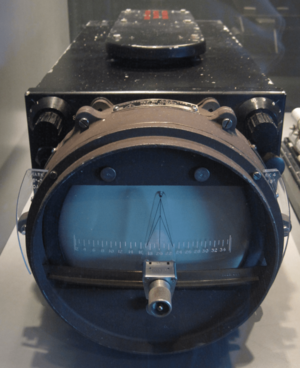
The first submarines only had a small window to see out for navigation. An early periscope was patented in 1893. The modern periscope was developed in the early 1900s and was put on most British Royal Navy submarines.
Passive sonar (listening for sounds) was used in submarines during World War I. But active sonar, called ASDIC by the British, didn't come into use until between the wars. Today, submarines can have many types of sonar systems, from ones in the front to ones that trail behind. They often have upward-looking sonars for under-ice travel and depth sounders.
Early experiments with using sound to "echo locate" underwater, like bats use sound for flying, began in the late 1800s. The first patent for an underwater echo ranging device was filed in 1912, a month after the Titanic sank. World War I sped up research in this area. The British used underwater hydrophones (underwater microphones), while French physicist Paul Langevin worked on active sound devices using quartz to detect submarines in 1915. In 1916, Canadian physicist Robert William Boyle and A B Wood created the world's first practical active underwater sound detection device for the British Navy, working in secret.
By 1918, both France and Britain had built prototype active sonar systems. The British tested their ASDIC in 1920 and started production in 1922. By 1923, some destroyer ships had ASDIC. A special anti-submarine school and training fleet were set up in England in 1924. The U.S. Sonar QB set arrived in 1931.
Weapons and Defenses
Early submarines carried torpedoes attached to the outside. Later designs put the weapons inside the submarine. Originally, torpedo tubes were at both the front and back, but back tubes eventually became less common. Today, only front-mounted tubes are used. Modern submarines can fire many types of weapons from their launch tubes, including UAVs (drones). Special submarines for laying mines were also built. Until the end of Second World War, submarines often had deck guns to sink ships without wasting their limited torpedoes.
To help aim weapons, mechanical calculators were used to improve the fire control of the weapons. The calculations were based on the target's course and speed, measured by the angle and distance seen through the periscope. Today, computers do these calculations, with screens showing information about the torpedoes and the submarine's status.
German submarines in World War II had rubber coatings and could launch chemical devices to create a decoy when attacked. These didn't work well, as sonar operators learned to tell the difference between the decoy and the submarine. Modern submarines can launch various devices for the same purpose.
Safety
After the A1 submarine sank in 1904, British submarines were fitted with lifting eyes, and in 1908, air-locks and escape helmets were provided. The Royal Navy tried different escape devices, but it wasn't until 1924 that the "Davis Submerged Escape Apparatus" was developed for crew members. The U.S. Navy used the similar "Momsen Lung". The French used "Joubert's apparatus," and the Germans used "Draeger's apparatus."
Rescue submarines for evacuating a disabled submarine's crew were developed in the 1970s. A British unmanned vehicle helped rescue a trapped Russian submarine crew in 2005. A new NATO Submarine Rescue System began service in 2007.
Wireless radio was used for communication with submarines in First World War. The D-class submarine was the first to have wireless transmitters in 1907. Over time, communication systems improved in type, range, and bandwidth. Because of the danger of interception, submarines try to transmit as little as possible. Various periscope-mounted aerials have been developed to allow communication without surfacing.
Early submarines navigated by sight and with a compass. The gyrocompass was introduced in the early 1900s, and inertial navigation systems in the 1950s. Using satellite navigation is limited for submarines, as it only works at periscope depth or when surfaced.
Submarines in Warfare
The first military submarine was Turtle in 1776. During the American Revolutionary War, Turtle tried but failed to sink a British warship in New York harbor in 1776.
During the War of 1812, in 1814, Silas Halsey died while using a submarine in an unsuccessful attack on a British warship.
American Civil War

During the American Civil War, the Union was the first to use a submarine. The French-designed Alligator was the first U.S. Navy submarine and the first to have compressed air for breathing and an air filtration system. It was also the first submarine to carry a diver lock, allowing a diver to plant electrically detonated mines on enemy ships. It was first hand-powered but later converted to a hand-cranked propeller. With a crew of 20, it was larger than Confederate submarines. The Alligator was 47 feet long and about 4 feet in diameter. It was lost in a storm in 1863 while being towed to its first combat mission.
The Intelligent Whale was built after the Civil War and caused the deaths of 39 men during trials.
The Confederate States of America used several human-powered submarines, including CSS H. L. Hunley. The first Confederate submarine was the 30-foot-long Pioneer, which sank a target ship during tests but was never used in combat. It was later scrapped. The similar Bayou St. John submarine is preserved in a museum. The CSS Hunley was meant to attack Union ships blocking Confederate ports. It had a long pole with an explosive charge at the front, called a spar torpedo. The submarine had to get close to an enemy ship, attach the explosive, move away, and then detonate it. It was very dangerous to operate. It sank twice, once killing half the crew, and the second time, all eight crew members, including Hunley himself, drowned. On February 17, 1864, the Hunley sank the USS Housatonic off Charleston Harbor. This was the first time a submarine successfully sank another ship, though the Hunley also sank shortly after. Submarines didn't change the outcome of the war much, but they showed how important they would become in naval warfare.
World War I
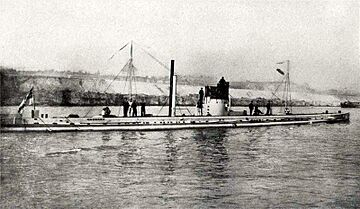
Submarines had a big impact for the first time in World War I. German U-boats attacked Allied merchant ships. Submarines became effective war machines thanks to new tactics, their growing numbers, and technologies like the combination diesel/electric power system. Early submarines were more like submersible ships than modern submarines. They mainly operated on the surface using standard engines, only diving occasionally to attack using battery power. They were roughly triangular in shape to help with stability on the surface.
Before World War I, Italian and Greek navies used submarines, but they didn't see much action. The Greek Delfin was the first to launch a torpedo at an enemy ship, though it missed.
At the start of the war, Germany had 48 submarines, with 29 ready for action. These included the diesel-engined U-19 class, which could travel 5,000 nautical miles and go 8 knots, allowing them to operate around the entire British coast. Initially, Germany followed international "Prize Rules," which required allowing a ship's crew to leave before sinking their ship. U-boats saw action in the First Battle of the Atlantic.
After the British ordered transport ships to act as armed merchant ships, the German navy started unrestricted submarine warfare, often attacking without warning. During the war, 360 submarines were built, but 178 were lost. The rest were surrendered at the end of the war. A German U-boat sank the RMS Lusitania, which is often cited as one reason the United States entered the war.
In August 1914, ten U-boats sailed from their base to attack British warships in the North Sea. This was the first submarine war patrol in history. Their goal was to sink large British warships to reduce the British fleet's advantage. The first mission wasn't very successful, with only one attack and two U-boats lost. However, the SM U-9 had better luck. On September 22, 1914, U-9 found three older British armored cruisers and sank all three in less than an hour, firing all six of its torpedoes and reloading underwater.
The British had 77 operational submarines at the start of the war. The main type was the E class, but they also built experimental designs like the K class, known for bad luck, and the M class, which had a large deck gun. The R class was the first submarine designed to attack other submarines. British submarines operated in the Baltic, North Sea, Atlantic, Mediterranean, and Black Sea. Over 50 were lost during the war.
France had 62 submarines at the start of the war. They mainly operated in the Mediterranean. Twelve were lost during the war. Russia started the war with 58 submarines. Their main class was the Bars class. Twenty-four Russian submarines were lost during the war.
World War II
Germany
Even though Germany was forbidden from having submarines by the Treaty of Versailles, they secretly started building them in the 1930s. When this became known, the Anglo-German Naval Agreement of 1936 allowed Germany to have as many submarines as Britain.
Germany started the war with only 65 submarines. They soon built the largest submarine fleet during World War II. Because the Treaty of Versailles limited their surface navy, Germany focused on building submarines, which could be built faster. Over a thousand submarines were built by the end of the war.
Germany used submarines very effectively in World War II during the Battle of the Atlantic. They tried to cut off Britain's supply routes by sinking more ships than Britain could replace. These supply lines were vital for Britain's food, industry, and weapons from Canada and the United States. Although U-boats had been updated, the major improvement was better communications, encrypted using the famous Enigma cipher machine. This allowed for "wolfpack" tactics, where groups of submarines attacked together.
After leaving port, U-boats usually operated alone, searching for convoys in assigned areas. If a convoy was found, the submarine wouldn't attack immediately. Instead, it would follow the convoy and radio its location to German Command, allowing other submarines to find it. The submarines would then form a larger attack group and attack the convoy at the same time, preferably at night while surfaced to avoid ASDIC (sonar).
In the first few years of World War II, the Ubootwaffe ("U-boat force") had great success with these tactics, but they didn't have enough submarines to win decisively. By spring 1943, German U-boat production was at full capacity. However, this was canceled out by more convoy escorts and aircraft, as well as new technologies like radar and sonar. High Frequency Direction Finding (HF/DF, or Huff-Duff) and Ultra (decoded Enigma messages) allowed the Allies to steer convoys away from wolfpacks when they detected U-boat radio transmissions. The results were terrible for the U-boats: from March to July 1943, over 130 U-boats were lost, 41 in May alone. Allied losses dropped sharply. Even though the Battle of the Atlantic continued until the last day of the war, the U-boat force couldn't stop the flow of supplies, which helped lead to major Allied invasions. Winston Churchill said the U-boat "peril" was the only thing that made him doubt an Allied victory.
By the end of the war, almost 3,000 Allied ships were sunk by U-boats. Of the 40,000 men in the U-boat service, 28,000 (70%) died.
The Germans built some unique submarine designs, including the Type XVII, which used hydrogen peroxide in a Walther turbine for propulsion. They also produced the Type XXII, which had a large battery and mechanical torpedo handling.
Italy
Italy had 116 submarines at the start of the war. They mainly operated in the Mediterranean. Some were sent to a base in France. A group of submarines also operated from the Eritrean port of Massawa.
Italian submarine designs weren't very suitable for the Atlantic Ocean. Italian midget submarines were used to attack British shipping near Gibraltar.
Britain
The Royal Navy Submarine Service had 70 operational submarines in 1939. Three classes were chosen for mass production: the seagoing S class, the oceangoing T class, and the coastal U class. All of these were built in large numbers during the war.
The French submarine fleet had over 70 vessels at the start of the war. After the Fall of France, the French-German Armistice required all French submarines to return to German-controlled ports. Some of these were seized by British forces.
British submarines mainly operated off the coast of Norway, in the Mediterranean, and in the North Sea. In the Mediterranean, a group of submarines successfully disrupted the Axis supply route to North Africa from their base in Malta. Over three years, this force sank over 1 million tons of shipping, severely weakening German efforts to support General Erwin Rommel. Rommel's Chief of Staff admitted that they would have reached the Suez Canal if not for the British submarines. Forty-five British submarines were lost in this campaign.
British submarines also attacked Japanese shipping in the Far East during the Pacific campaign. They conducted reconnaissance, stopped Japanese supplies going to Burma, and attacked U-boats. By October 1944, the British submarine force had sunk a cruiser, three submarines, six small naval vessels, 40,000 tons of merchant ships, and nearly 100 small vessels. In this area, the only known instance of one submarine sinking another while both were submerged occurred. HMS Venturer engaged the U864, and the Venturer crew manually calculated a successful firing solution against a moving target.
By March 1945, British boats controlled the Strait of Malacca, preventing supplies from reaching Japanese forces in Burma by sea. By this time, there were few large Japanese ships, so submarines mainly attacked small ships with their deck guns. The submarine HMS Trenchant sank the heavy cruiser Ashigara, carrying about 1,200 Japanese army troops. Three British submarines were sunk by the Japanese during the war.
Japan
Japan had the most varied fleet of submarines in World War II. This included manned torpedoes (Kaiten), midget submarines, medium-range submarines, supply submarines, long-range fleet submarines (many carrying an aircraft), submarines with the highest submerged speeds (Sentaka I-200), and submarines that could carry multiple aircraft (the largest submarine of World War II, the Sentoku I-400). These submarines also had the most advanced torpedo of the war, the oxygen-propelled Type 95.
Overall, despite their advanced technology, Japanese submarines were not very successful. This was because they were mainly used to attack warships, which were fast, maneuverable, and well-defended compared to merchant ships. In 1942, Japanese submarines sank two aircraft carriers, one cruiser, and several destroyers, and damaged many others, including two battleships. They couldn't keep up these results as Allied fleets grew stronger and better organized. By the end of the war, submarines were often used to transport supplies to island garrisons. During the war, Japan sank about 1 million tons of merchant shipping, much less than other countries.
Early Japanese submarines were not very maneuverable underwater, couldn't dive very deep, and lacked radar. Later in the war, units with radar were sometimes sunk because U.S. radar could detect their emissions. For example, USS Batfish sank three such submarines in four days. After the war, several of Japan's most unique submarines were sent to Hawaii for inspection before being sunk by the U.S. Navy in 1946, when the Soviets demanded access to them.
United States
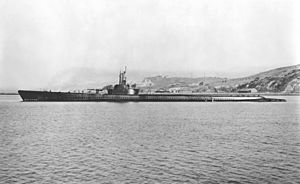
After the attack on Pearl Harbor, many U.S. Navy surface ships were destroyed or badly damaged. But the submarines survived and continued the fight against the enemy. Without support ships, the submarines had to independently hunt and destroy Japanese ships and submarines. They did this very effectively.
During World War II, the submarine force was the most effective anti-ship and anti-submarine weapon in the entire American arsenal. Submarines, though only about 2 percent of the U.S. Navy, destroyed over 30 percent of the Japanese Navy, including 8 aircraft carriers, 1 battleship, and 11 cruisers. U.S. submarines also destroyed over 60 percent of the Japanese merchant fleet, severely hurting Japan's ability to supply its military and industry. Allied submarines in the Pacific War destroyed more Japanese shipping than all other weapons combined. This was helped by the Japanese Navy's failure to provide enough escort ships for its merchant fleet.
While Japanese submarine torpedoes of the war are considered the best, those of the U.S. Navy are considered the worst. For example, the U.S. Mark 14 torpedo often ran 10 feet too deep and had unreliable detonators. The depth problem was fixed in August 1942, but the detonator flaws weren't confirmed until mid-1943. Also, the Mark 14 sometimes made circular runs, which sank at least one U.S. submarine, Tullibee. Fully working Mark 14 torpedoes weren't used until September 1943. The Mark 15 torpedo used by U.S. surface ships had the same faulty detonator and wasn't fixed until late 1943. One attempt to fix problems resulted in a wakeless, electric torpedo (the Mark 18) being used. Tang was lost to a circular run by one of these torpedoes.
During World War II, 314 submarines served in the United States Navy, with nearly 260 deployed to the Pacific. On December 7, 1941, 111 boats were in service, and 203 new submarines were commissioned during the war. Fifty-two U.S. submarines were lost, with 48 directly due to fighting; 3,505 sailors were lost, the highest percentage killed in action of any U.S. service branch in World War II. U.S. submarines sank 1,560 enemy vessels, totaling 5.3 million tons (55% of all ships sunk), including 8 aircraft carriers, a battleship, three heavy cruisers, and over 200 other warships. They also damaged several other ships, including the battleships Yamato and Musashi. Additionally, the Japanese merchant marine lost 16,200 sailors killed due to submarines.
Post-War
During the Cold War, the United States and the Soviet Union had large submarine fleets that played "cat-and-mouse" games. This continues today, though on a much smaller scale. The Soviet Union lost at least four submarines during this time: K-129 in 1968 (which the CIA tried to retrieve), K-8 in 1970, K-219 in 1986, and Komsomolets in 1989. Many other Soviet submarines, like K-19, were badly damaged by fire or radiation leaks. The United States lost two nuclear submarines: USS Thresher and Scorpion. The Thresher was lost due to equipment failure, and the exact cause of the Scorpion's loss is unknown.
The sinking of PNS Ghazi in the Indo-Pakistani War of 1971 was the first submarine loss in the South Asian region.
The United Kingdom used nuclear-powered submarines against Argentina during the 1982 Falklands War. The sinking of the cruiser ARA General Belgrano by HMS Conqueror was the first sinking by a nuclear-powered submarine in war. During this conflict, the conventional Argentinian submarine ARA Santa Fé was disabled, and the ARA San Luis claimed to have made unsuccessful attacks on the British fleet.
Major Submarine Incidents
There have been many accidental sinkings and collisions between submarines. Up to August 1914, there were 68 submarine accidents. These included 23 collisions, 7 battery gas explosions, 12 gasoline explosions, and 13 sinkings because hull openings were not closed. HMS Affray was lost in the English Channel in 1951 due to a broken snorkel mast. USS Thresher was lost in 1963 due to a pipe weld failure during a test dive. Many other things can cause sinkings, such as a battery problem causing a torpedo to explode inside, and the loss of the Russian Kursk on August 12, 2000, probably due to a torpedo explosion. An example of a collision was between the Russian K-276 and the USS Baton Rouge in February 1992.
Since 2000, there have been 9 major naval incidents involving submarines. These include three Russian submarine incidents (two lost), three United States submarine incidents, one Chinese, one Canadian, and one Australian incident. In August 2005, AS-28, a Russian rescue submarine, was trapped by cables off Petropavlovsk. It was saved when a British remote-controlled vehicle cut them free in a large international effort.
Images for kids
-
Submarine by William Bourne, in Inventions or devices, 1578.
-
Submarine of Cornelius Jacobszoon Drebbel, 1620 and 1624.
-
Denis Papin's submarine, second design, 1690.
-
The Nordenfelt-designed, Ottoman submarine Abdül Hamid
-
Drzewiecki-designed submarine built in 1881 and now in the Central Naval Museum, Saint Petersburg
-
HMS M2 launches a specially designed Parnall Peto seaplane. It sank accidentally in 1932.
-
Tang off Mare Island in 1943.
See Also
- List of submarine actions
- List of submarine museums
- List of sunken nuclear submarines
- Depth charge
- Nuclear navy
- Nuclear submarine
- Attack submarine
- List of countries with submarines
Vessels
- Nerwin (NR-1)
- Vesikko (museum submarine)
- ORP Orzeł
- Ships named Nautilus
- List of submarines of the Royal Navy
- List of submarines of the United States Navy
- List of Soviet submarines
- List of U-boats of Germany
- Kaikō ROV (deepest submarine dive)
- Bathyscaphe Trieste (deepest manned dive)
Classes
- List of submarine classes
- List of submarine classes of the Royal Navy
- List of Soviet and Russian submarine classes
- List of United States submarine classes


